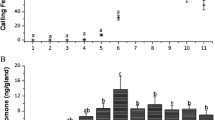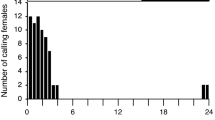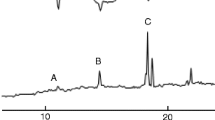Abstract
We studied the post-flight behavior and sex attraction in imagoes of the termite Prorhinotermes simplex (Rhinotermitidae, Prorhinotermitinae). Pairing is mediated by the secretion from tergal glands, exposed by females in a calling posture and highly attractive to males. Analysis of extracts of these glands by means of gas chromatography with electroantennographic detection indicated a chromatographic area corresponding to an intense physiological response of males. The retention characteristics of this area proved to be identical with those of (3Z,6Z,8E)-dodeca-3,6,8-trien-1-ol. Electroantennographic and behavioral assays revealed that units of picograms of the compound represent a stimulus qualitatively and quantitatively equivalent to one female tergal gland. Thus, we hypothesize that (3Z,6Z,8E)-dodeca-3,6,8-trien-1-ol is a major component of the female sex pheromone in P. simplex.



Similar content being viewed by others
References
Adams R.P. 2007. Identification of Essential Oil Components by Gas Chromatography/Mass Spectrometry, 4th Ed. Allured Publishing Corp., Carol Stream, Illinois, 804 pp
Ampion M. and Quennedey A. 1981. The abdominal epidermal glands of termites and their phylogenetic significance. Syst. Assoc. (Special Volume) 19: 249–261
Austin J.W., Szalanski A.L. and Cabrera B.J. 2004. Phylogenetic analysis of the subterranean termite family Rhinotermitidae (Isoptera) by using the mitochondrial cytochrome oxidase II gene. Annls Entomol. Soc. Am. 97: 548–555
Banks N. and Snyder T.E. 1920. A Revision of the Nearctic Termites. Government Printing Office, Washington, 228 pp
Birch A.J., Brown W.V., Corrie J.E.T. and Moore B.P. 1972. Neocembrene-A, a termite trail pheromone. J. Chem. Soc. 1: 2653–2658
Bland J.M., Park Y.I., Raina A.K., Dickens J.C. and Hollister B. 2004. Trilinolein identified as a sex-specific component of tergal glands in alates of Coptotermes formosanus. J. Chem. Ecol. 30: 835–849
Bordereau C., Robert A., Bonnard O. and Le Quéré J.-L. 1991. (3Z,6Z,8E)-3,6,8-dodecatrien-1-ol: sex pheromone in a higher fungus-growing termite, Pseudacanthotermes spiniger (Isoptera, Macrotermitinae). J. Chem. Ecol. 17: 2177–2191
Bordereau C., Robert A., Laduguie N., Bonnard O., Le Quéré J.-L. and Yamaoka R. 1993. Détection du (3Z,6Z,8E)-3,6,8-dodecatrien-1-ol par les termites ouvriers et les essaimants de deux espèces de termites champignonnistes : Pseudacanthotermes spiniger et Pseudacanthotermes militaris (Termitidae, Macrotermitinae). Actes Coll. Insectes Soc. 8: 145–149
Bordereau C., Cancello E.M., Sémon E., Courrent A. and Quennedey B. 2002. Sex pheromone identified after Solid Phase Microextraction from tergal glands of female alates in Cornitermes bequaerti (Isoptera, Nasutitermitinae). Insect. Soc. 49: 209–215
Bordereau C., Lacey M., Ghostin J., Braekman J.-C., Sillam-Dussès D., Robert A., Shellman J.S. and Sémon E. 2006. Sex pheromones and trail-following pheromones in Zootermopsis nevadensis and Z. angusticollis (Isoptera, Termopsidae). Proc. 15 th Int. IUSSI Congr., Washington DC, USA. p 531
Clément J.-L. 1982. Sexual pheromones in European termites of the genus Reticulitermes: behavior and specific isolation. Biol. Behav. 7: 55–68
Clément J.-L., Lloyd H., Nagnan P. and Blum M.S. 1989. n-Tetradecyl propionate: identification as a sex pheromone of the eastern subterranean termite Reticulitermes flavipes. Sociobiology 15: 19–24
Emerson A.E. 1955. Geographical origin and dispersions of termite genera. Fieldiana, Zoology 37: 465–521
Hall P. and Traniello J.F.A. 1985. Behavioral bioassays of termite trail pheromones. Recruitment and orientation effects of cembrene-A in Nasutitermes costalis (Isoptera: Termitidae) and discussion of factors affecting termite response in experimental contexts. J. Chem. Ecol. 11: 1503–1513
Inward D.J.G., Vogler A.P. and Eggleton P. 2007. A comprehensive phylogenetic analysis of termites (Isoptera) illuminates key aspects of their evolutionary biology. Mol. Phylogen. Evol. 44: 953–967
Laduguie N., Robert A., Bonnard O., Vieau F., Le Quéré J.-L., Sémon E. and Bordereau C. 1994. Isolation and identification of (3Z,6Z,8E)-3,6,8-dodecatrien-1-ol in Reticulitermes santonensis Feytaud (Isoptera, Rhinotermitidae): roles in worker trail-following and in alate sex-attraction behavior. J. Insect Physiol. 40: 781–787
Legendre F., Whiting M.F., Bordereau C., Cancello E.M., Evans T.A. and Grandcolas P. 2008. The phylogeny of termites (Dictyoptera: Isoptera) based on mitochondrial and nuclear markers: implications for the evolution of the worker and pseudergate castes, and foraging behaviors. Mol. Phylogen. Evol. 48: 615–627
Leuthold R. 1977. Postflight communication in two termite species, Trinervitermes bettonianus and Hodotermes mossambicus. Proc. 8th Int. Congr. IUSSI, Wageningen, pp 62–64
Leuthold R.H. and Bruinsma O. 1977. Pairing behavior in Hodotermes mossambicus (Isoptera). Psyche 84: 109–119
Lo N., Kitade O., Miura T., Constantino R. and Matsumoto T. 2004. Molecular phylogeny of the Rhinotermitidae. Insect. Soc. 51: 365–371
Matsuura K., Kuno E. and Nishida T. 2002. Homosexual tandem running as selfish herd in Reticulitermes speratus: novel antipredatory behavior in termites. J. Theor. Biol. 214: 63–70
McDowell P.G. and Oloo G.W. 1984. Isolation, identification, and biological activity of trail-following pheromone of termite Trinervitermes bettonianus (Sjöstedt) (Termitidae: Nasutitermitinae). J. Chem. Ecol. 10: 835–851
Noirot C. 1969. Glands and secretions. In: Biology of Termites, Vol. 1 (Krishna K. and Weesner F.M., Eds), Academic Press, New York London, pp 89–123
Nutting W.L. 1969. Flight and colony foundation. In: Biology of Termites, Vol. 1 (Krishna K. and Weesner F.M., Eds), Academic Press, New York London, pp 233–282
Ohkuma M., Yuzawa H., Amornsak W., Sornnuwat Y., Takematsu Y., Yamada A., Vongkaluang C., Sarnthoy O., Kirtibutr N., Noparatnaraporn N., Kudo T. and Inoue T. 2004. Molecular phylogeny of Asian termites (Isoptera) of the families Termitidae and Rhinotermitidae based on mitochondrial COII sequences. Mol. Phylogen. Evol. 31: 701–710
Pasteels J.M. 1972. Sex-specific pheromones in a termite. Experientia 28: 105–106
Pasteels J.M. and Bordereau C. 1998. Releaser pheromones in termites. In: Pheromone Communication in Social Insects: Ants, Wasps, Bees and Termites (Vander Meer R.K., Breed M.D., Espelie K.E. and Winston M.L., Eds), Westview Press, Boulder, pp 193–215
Peppuy A., Robert A. and Bordereau C. 2004. Species-specific sex pheromones secreted from new sexual glands in two sympatric fungus-growing termites from northern Vietnam, Macrotermes annandalei and M. barneyi. Insect. Soc. 51: 91–98
Quennedey A. and Deligne J. 1975. L′arme frontale des soldats de termites. I. Rhinotermitidae. Insect. Soc. 22: 243–267
Quennedey A., Peppuy A., Courrent A., Robert A., Everaerts C. and Bordereau C. 2004. Ultrastructure of posterior sternal glands of Macrotermes annandalei (Silvestri); new member of the sexual glandular set found in termites (Insecta). J. Morphol. 262: 683–691
Quennedey A., Sillam-Dussès D., Robert A. and Bordereau C. 2008. The fine structural organization of sternal glands of pseudergates and workers in termites (Isoptera): a comparative survey. Arthropod Struct. Devel. 37: 168–185
Robert A., Peppuy A., Sémon E., Boyer F.D., Lacey M.J. and Bordereau C. 2004. A new C12 alcohol identified as a sex pheromone and a trail-following pheromone in termites: the diene (Z,Z)-dodeca-3,6-dien-1-ol. Naturwissenschaften 91: 34–39
Roisin Y. 1988. Morphology, development and evolutionary significance of the working stages in the caste system of Prorhinotermes (Insecta, Isoptera). Zoomorphology 107: 339–347
Rupf T. and Roisin Y. 2008. Coming out of the woods: do termites need a specialized worker caste to search for new food sources? Naturwissenschaften 95: 811–819
Sillam-Dussès D., Sémon E., Moreau C., Valterová I., Šobotník J., Robert A. and Bordereau C. 2005. Neocembrene A, a major component of the trail-following pheromone in the genus Prorhinotermes (Insecta, Isoptera, Rhinotermitidae). Chemoecology 15: 1–6
Šobotník J. and Hubert J. 2003. The morphology of the exocrine glands of Prorhinotermes simplex (Isoptera: Rhinotermitidae) and their ontogenetical aspects. Acta Soc. Zool. Bohem. 67: 83–98
Šobotník J., Weyda F. and Hanus R. 2005. Ultrastructural study of tergal and posterior sternal glands in Prorhinotermes simplex (Isoptera: Rhinotermitidae). Eur. J. Entomol. 102: 81–88
Štys P. and Šobotník J. 1999. Comments on classifications of insect ontogenies, and occurence of proneometabolous wing development in termite genus Prorhinotermes (Hexapoda: Isoptera). Acta Soc. Zool. Bohem. 63: 483–492
Wall M. 1971. Geschlechtbiologie der Termite Kalotermes flavicollis (Fabr.) (Isoptera). Acta Tropica 28: 17–60
Wobst B., Farine J.P., Giniès C., Sémon E., Robert A., Bonnard O., Connétable S. and Bordereau C. 1999. (Z,Z,E)-3,6,8-dodecatrien-1-ol, a major component of trail-following pheromone in two sympatric termite species Reticulitermes lucifugus grassei and R. santonensis. J. Chem. Ecol. 25: 1305–1318
Acknowledgments
This research was supported by the Grant Agency of the Academy of Sciences of the Czech Republic (project No. A600550614), and by the Institute of Organic Chemistry and Biochemistry, Academy of Sciences of the Czech Republic, Prague (project No. Z4 055 0506). T. Bourguignon thanks the Fund for Scientific Research (F.R.S.–FNRS), Belgium, for a FRIA pre-doctoral fellowship. We would like to thank Prof. Jan Žďárek and Dr. David Sillam-Dussès (both IOCB, Prague) for critical reading of this manuscript and Nathan Fields for proofreading of the manuscript. We are also grateful to Jarmila Titzenthalerová for her help in experiments.
Author information
Authors and Affiliations
Corresponding author
Rights and permissions
About this article
Cite this article
Hanus, R., Luxová, A., Šobotník, J. et al. Sexual communication in the termite Prorhinotermes simplex (Isoptera, Rhinotermitidae) mediated by a pheromone from female tergal glands. Insect. Soc. 56, 111–118 (2009). https://doi.org/10.1007/s00040-009-0005-5
Received:
Revised:
Accepted:
Published:
Issue Date:
DOI: https://doi.org/10.1007/s00040-009-0005-5




